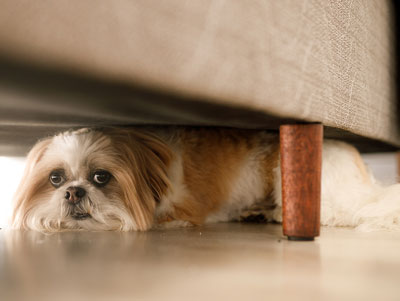Desensitization and Counterconditioning: Helping Your Dog with Fears

Counterconditioning is the process of helping a dog develop a positive association with a trigger instead of a negative one. Desensitization means exposing the dog to the trigger in small doses over time to help the dog get more used to it. The two techniques, when appropriately used together, can be quite useful in getting dogs over fear and anxiety.
Teach Your Dog a More Desirable Response to a Trigger
If your dog shows fear or anxiety to a stimulus, you can help her learn a different response. The best way to do that is to reward the behavior you want rather than punish the behavior you don't. Using punishment can make the behavior worse because your dog won't necessarily understand what you're punishing for. That can increase fear and anxiety rather than decreasing it.
Instead, use desensitization in conjunction with counterconditioning to get your dog to respond differently to the trigger and then reward your dog for that calm behavior.
Here is an example:
Say your dog is afraid of the vacuum. Here is how a desensitization and counterconditioning plan may look for you and your dog.
- Put your dog on a leash.
- Have someone in another room (as far away from you and your dog as possible), start the vacuum.
- Tell your dog to sit and reward with a treat when she does so.
- Stop the vacuum.
- If your dog was calm, sat when commanded, and received the treat, have the person come a bit closer with the vacuum.
- Repeat the steps, gradually getting closer to your dog with the vacuum while rewarding for calm behavior and ignoring fearful behavior.
- If your dog becomes agitated, return to the previous distance and work on it some more.
- Eventually, work up to having the vacuum in the same room as your dog while she stays calm.
Over time, your dog will learn that it's more rewarding to react calmly to the vacuum cleaner than to act fearfully around it.
General Tips for Desensitization and Counterconditioning
Here are some things to keep in mind when you are planning a desensitization and counterconditioning treatment for your dog:
- Limit training sessions to ten or fifteen minutes at a time.
- Use a high-value reward for positive behavior. That could be a treat your dog loves or a quick play session with a favorite toy. Always include verbal praise. Clicker training can speed up the process, and you can learn more about that here: "Clicker Training in Dogs: An Overview."
- Try to end each training session on a high note. Allow your dog to have some success, no matter how tiny, and reward her for it before ending the session.
If your dog's fear reaction is aggressive, don't attempt a desensitization and counterconditioning program on your own. Consult your veterinarian or a veterinary behavior specialist.
- Always stay positive and patient. If you get upset, your dog will, too, and that will slow down learning.
- Remember that the process can take a while. Don't expect your dog to get over a big fear in one or two training sessions.
Examples of When to Try Counterconditioning and Desensitization
Here are some examples of situations that may be improved by counterconditioning:
- Fireworks
- Storms
- Kids (this should be done very carefully to minimize danger)
- Vet visits
- Grooming
- Tooth brushing
- Steps
Additionally, the techniques can be used in situations where the dog is exhibiting overexcitement rather than fear, such as:
- When the doorbell rings
- When new people come in the home
- When you are getting out her food
Any situation in which you would like your dog to react differently than she is to a particular stimulus, you can use the techniques. Start small/slow/low and reward for the behavior you want. Gradually, make the stimulus larger/faster/louder or introduce more significant distractions. Any time your dog stops focusing on the positive response and succumbs to the old behavior, back up to the previous step for a bit longer.
You May Also Like These Articles:
Clicker Training for Dogs: An Overview
Disclaimer: This website is not intended to replace professional consultation, diagnosis, or treatment by a licensed veterinarian. If you require any veterinary related advice, contact your veterinarian promptly. Information at DogHealth.com is exclusively of a general reference nature. Do not disregard veterinary advice or delay treatment as a result of accessing information at this site. Just Answer is an external service not affiliated with DogHealth.com.
Notice: Ask-a-Vet is an affiliated service for those who wish to speak with a veterinary professional about their pet's specific condition. Initially, a bot will ask questions to determine the general nature of your concern. Then, you will be transferred to a human. There is a charge for the service if you choose to connect to a veterinarian. Ask-a-Vet is not manned by the staff or owners of DogHealth.com, and the advice given should not delay or replace a visit to your veterinarian.



